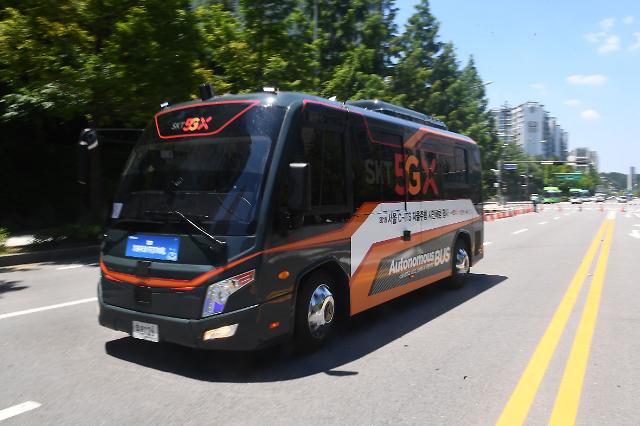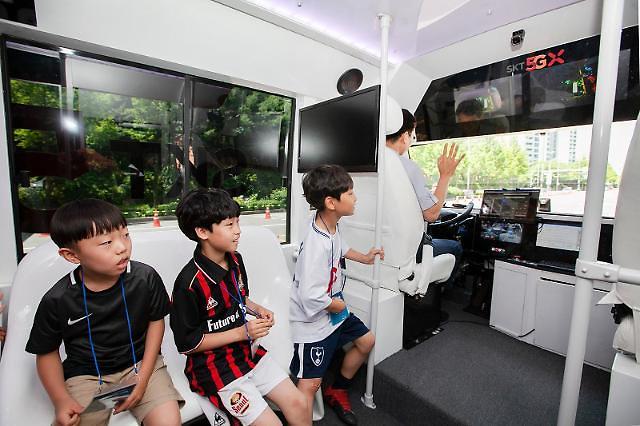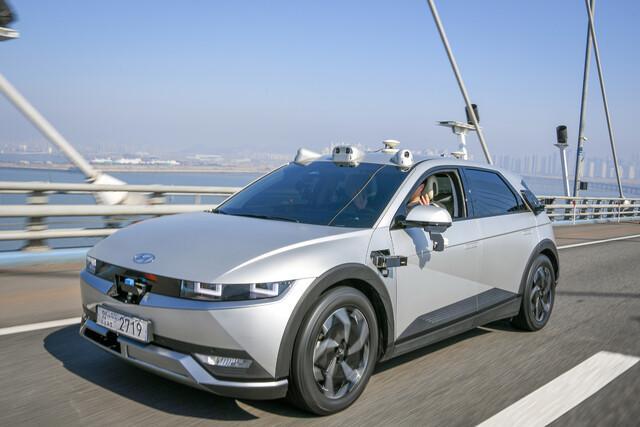
[Yonhap Photo]
The 11-seater bus moved along a street some 500 meters (0.3 miles) in Sangam Digital Media City (DMC), an industrial cluster of digital media and entertainment companies located in western Seoul, carrying citizens who were selected to experience the future public transport.
The event on Saturday was jointly arranged by SK Telecom (SKT), a top mobile carrier in South Korea, and the Seoul city government, the Ministry of Land, Infrastructure and Transport and the Ministry of Science and ICT.
The test drive was carried out in a controlled environment on a test bed which simulated Cooperative-Intelligent Transport Systems (C-ITS), a next-generation transport communication network infrastructure, to demonstrate self-driving technology using V2X (vehicle to everything) technology.
Vehicles and road facilities were connected with a 5G network to respond to various traffic signal information and unexpected situations on roads. Autonomous vehicles communicated with a control center
The self-driving bus was fitted with a level three autonomous system, which requires a human driver to intervene if necessary. It recognized traffic lights and pedestrians and slowed down safely and smoothly to a stop when an unexpected jaywalker appeared.

[Courtesy of SK Telecom]
The Seoul city government and SKT would jointly install C-ITS infrastructure across the capital city to cover 121.4 kilometers of roads by 2020. About 2,000 buses, taxis and passenger cars will be mounted with 5G-based V2X modules which would allow cars to send and receive data. Such traffic data will be used to guide emergency vehicles while alerting other cars about the emergency situation. Also, connected cars will share and report information about road damages such as potholes for rapid maintenance.
Using SKT's see-through technology, high-definition images sent by ADAS of a preceding vehicle were shown on the driver's display screen in real time. Recognition information from V2X server's AI analysis of pedestrians and traffic signs was displayed on the screen, enabling predictive operation.
The screen showed signals from sensors attached to the vehicle. SKT established 5G infrastructures for autonomous driving, applied an ultra-precision map, and established a monitoring system based on 5G and AI.
"We have implemented high-level autonomous driving with signal information that was sent in advance through a 5G network rather than just independent driving that relies on sensors," an SKT official said. "The 5G network was used while self-driving vehicles were exchanging information with roads."
A commercialized 5G mobile network is the key factor of autonomous driving infrastructures as self-driving cars and connected cars need to constantly transmit large data. Along with V2X networks and vehicle communication terminals, South Korea is building an infrastructure for connected car services such as ultra-low-latency communication.
KT has developed connected car platforms, infotainment systems and vehicle control platforms. The telecom company partnered with Unmanned Solution to launch a 5G network-based autonomous shuttle service at theme parks and industrial complexes.
On June 14, KT demonstrated its 5G-based V2X technology that can transmit data of various sizes without limitation in distance of telecommunication. In December last year, KT produced a C-V2X terminal which is instrumental in advancing vehicle connectivity for crash-free autonomous driving. C-V2X communicates to a cellular network for cloud-based services like navigation and infotainment. It uses a direct link to communicate with other vehicles, smart infrastructure and pedestrians.




